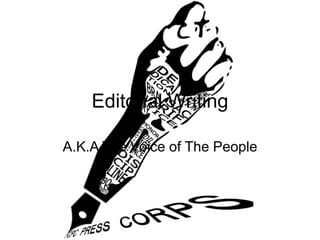
Editorial Writing Training Presentation.ppt
- 1. Editorial Writing A.K.A The Voice of The People
- 2. WHAT IS AN EDITORIAL? An editorial is an article which presents the writer and newspaper’s opinion on an issue. Much in the same manner of a lawyer, editorial writers build on an argument and try to persuade readers to think the same way they do. Editorials are meant to influence public opinion, promote critical thinking, and sometimes cause people to take action on an issue. In essence, an editorial is an opinionated news story.
- 3. PARTS OF AN EDITORIAL 1. Lede - should have a news peg, and an opinion on the issue showing your side (positive or negative). 2. Body- should contain facts from CREDIBLE sources and your defense/offense of an opinion. 3. Conclusion- should summarize the entire article, ending it with a striking question, and/or solution to the problem.
- 4. FOUR TYPES OF EDITORIALS 1. Editorial of Information- it seeks to give information on facts of news stories or add other facts with minimum explanation. It may define terms, identify persons or factors or provide a background. 2. Editorial of Criticism- it points out the good and/or bad in an issue and its purpose is to influence readers as it suggests a solution at the end. 3. Editorial of Argumentation- this is oftentimes called the editorial of persuasion. The editor argues in order to convince or persuade the reader to accept his stand on the issue. 4. Editorial of Commendation- it commends a certain person or organization that has done something praise-worthy.
- 5. SAMPLE EDITORIAL Children in the Crosshairs Twisted ideologies have now corrupted the minds of our youth as government troops continuously receive disturbing narratives from escapees that children are being employed by the Mautes to fight for the wrong cause. Kill or be killed—that’s their motto. With specific duties to target and kill government soldiers, child soldiers are the deadliest combatants—no conscience and no hesitation while we abide the rules of engagement. According to Rappler, the Mautes have been brainwashing children starting a few years ago. They first teach you the lessons of the Koran but after a month, they give you a rifle and teach you how to kill. Under International Law, recruiting and using children under the age of 15 as soldiers is prohibited under humanitarian law and is defined as a war crime by the International Criminal Court. Therefore, the insurgents did not only rebel against the government, they also broke a humanitarian law. Children have no place in a war zone. They do not deserve to be victims of a conflict nor do they deserve to be a part of it. Jose Rizal said that children are the future of our great nation. Surely, seeing what has happened to some of them in Marawi—blindly following the wrong beliefs, would make our national hero burst into tears. Armed Forces Spokesperson Brig. Gen. Restituto Padilla’s decision is sound. Soldiers need to save the children if possible; shooting only when necessary. The lives of soldiers are at stake. Therefore, we cannot indulge every humanitarian’s whim. Injuring a child for shooting at government personnel is one thing and killing a child is another. Know the difference.
- 6. GUIDELINES FOR EDITORIAL WRITING Legend: Tips= * 1. Know the issue 2. Research about the issue *Much better if you can gather data from various sources including tv, radio, newspaper, magazines and etc. 3. Choose a stand (positive/ negative, agree/disagree) *Only 1 stand should be evident in the whole article *Much better if your stand is unique and striking. 4. Make your lead paragraph *For starters, you may adopt other styles from local papers. But always remember that each writer has his/her own style *Must contain the news peg, the issue + your stand or the other way around
- 7. GUIDELINES FOR EDITORIAL WRITING 5. Must support the stand with facts and arguments. *You can experiment on this part. Meaning, the way your present data and argue will be your playground in order to make your article *Sources must be acknowledged properly in order to make your article stronger 6. Start strong, finish strong. Make a conclusion that summarizes the whole article in a paragraph *It is usually better to finish off with a solution (preferably a diplomatic one) to a problem in the conclusion.
- 8. THANK YOU FOR LISTENING. NOW, LET’S GET WRITING ☺